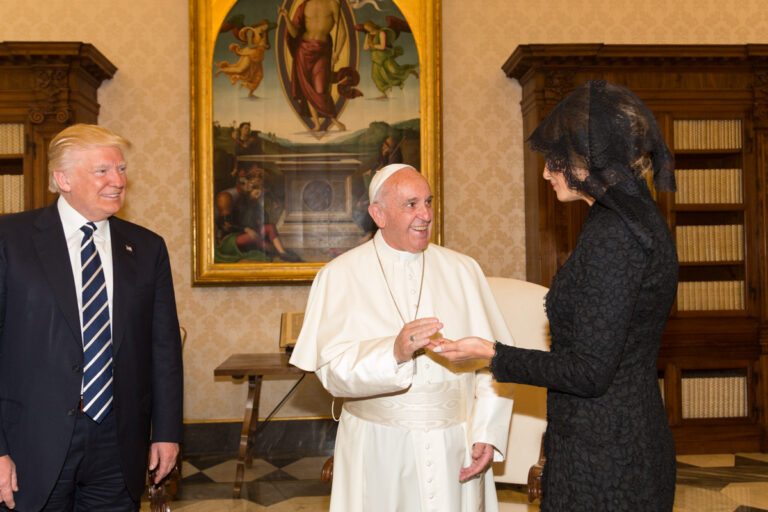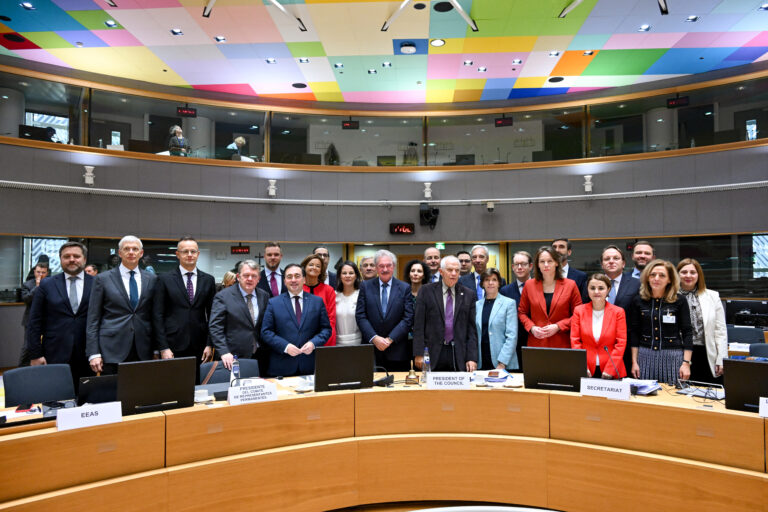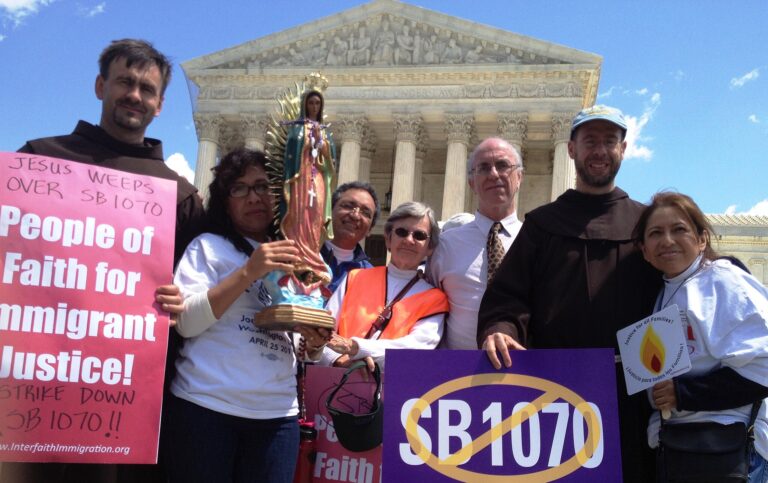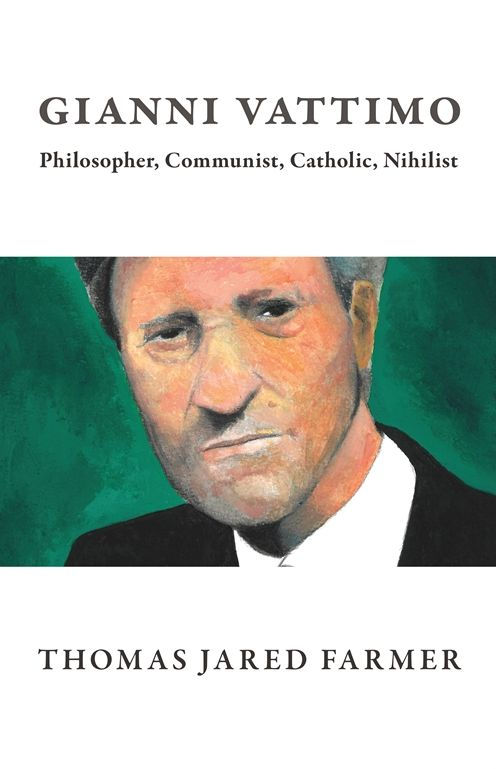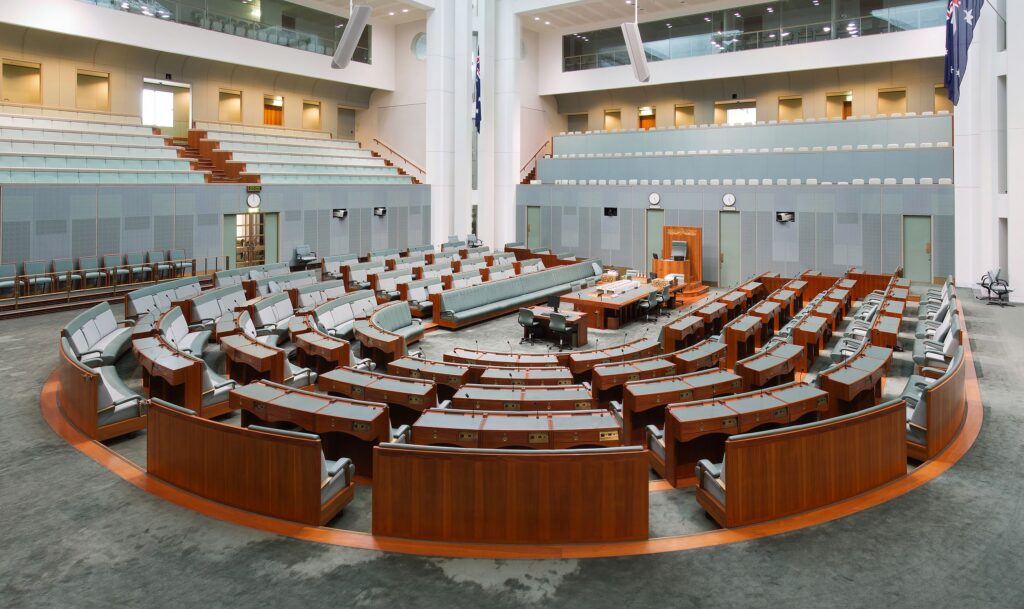
The Constitutional Limits of Aid to Students in Faith-Based Schools in The United States and Australia: A Brief Comparative Analysis
Charles J. Russo and P. T. Babie
Australian House of Representatives by JJ Harrison (CC BY-SA 3.0).
The constitutional protections for religious freedom and against the establishment of state religions in the United States and Australia bear a striking similarity. Under the First Amendment to the United States Constitution, approved as part of the Bill of Rights in 1791, “Congress shall make no law respecting an establishment of religion, or prohibiting the free exercise thereof.” In like manner, Section 116 of the Australian Constitution, which came into effect in 1901, guarantees that “the Commonwealth [the federal government] shall not make any law for establishing any religion…or for prohibiting the free exercise of any religion.” This is unsurprising because the framers of the Australian Constitution were Americanophiles who borrowed extensively from the American model.
While one might expect that the judicial interpretation of the relevant provisions would also follow a similar course, historically, this has not been so. One sees this in the treatment of the extent to which the state qua government may provide assistance for faith-based schools. In their earliest jurisprudence on the matter, the American courts initially allowed some accommodation, later moving to strict separation between the state and faith-based schools. By contrast, the Australian judiciary has taken a much more accommodationist position, allowing for considerable financial support to be given to schools, both state and non-government, that teach religion.
In short, the two nations took divergent stances—until relatively recently. This piece examines the current positions in the two jurisdictions, revealing how, in recent years, both have begun to converge around accommodation of at least some state support for faith-based schools. We do this in three parts: the first considers the American situation, exploring the changing views of the Establishment Clause as applied to faith-based schools, the second considers the Australian interpretation of Section 116 of its Constitution, and the final section offers brief reflections on the convergence of the two positions.
United States
The Supreme Court’s controversial First Amendment jurisprudence concerning constitutional limits on aid to faith-based schools has passed through three phases. During the first, which began in 1947 with Everson v. Board of Education, allowing local school boards in New Jersey to transport children to and from their faith-based schools the justices enunciated what is referred to as the Child Benefit Test , a legal construct it never used, permitting state aid because it assists children rather than their faith-based schools. This phase ended in 1968 with Board of Education of Central School District No. 1 v. Allen, permitting New York, and by extension, other states, to provide textbooks for secular instruction to students who attended faith-based schools.
The second phase, which started in 1971 with Lemon v. Kurtzman, a dispute from Pennsylvania, and its companion case from Rhode Island, Earley v. DiCenso, in which it created what became an increasingly unworkable tripartite test evaluating the constitutionality of aid to faith-based schools. Under this seemingly ubiquitous test courts had to consider whether “First, the statute must have a secular legislative purpose; second, its principal or primary effect must be one that neither advances nor inhibits religion; finally, the statute must not foster ‘an excessive government entanglement with religion.'” This period marked the nadir of the Child Benefit Test as the Justices largely refused to move beyond the limits they created in Everson and Allen. In 1993, in Zobrest v. Catalina Foothills School District, the Court breathed new life into the Child Benefit Test, presaging a new era on aid in holding that a public board in Arizona could not deny a student who was deaf the services of a sign language interpreter so he could attend a Catholic high school.
The third phase began in 1997 with Agostini v. Felton as the justices dissolved the Court’s injunction from 1985’s Aguilar v. Felton banning the on-site delivery of federal educational programming for underprivileged children in New York City. With Agostini the Court initiated the third phase extending to the present. As such, the remainder of this section focuses on developments since 1997 because the United States is currently in a period of permitting the greatest amount of aid to faith-based schools in its history.
More recently, the third phase of this constitutional story has become more complicated. Since 2017, the Court handed down a trilogy of opinions, all of which were authored by Chief Justice Roberts, marking the contemporary landscape surrounding aid to faith-based schools. The first was Trinity Lutheran Church of Columbia v. Comer, in which the Court allowed assistance to enhance playground safety in a Missouri preschool facility. Roberts emphasized that denying generally available funding to Trinity Lutheran “for which it is otherwise qualified, solely because it is a church, is odious to our Constitution all the same, and cannot stand.” Three years later, Espinoza v. Montana Department of Revenue further expanded government aid to students in faith-based schools in a dispute over the state’s tax credit program. The Court invalidated a provision in the state constitution denying aid because it was more restrictive than the federal free exercise clause. In 2022’s Carson v. Makin, the justices reasoned that Maine’s tuition assistance designed to aid parents in districts lacking public secondary schools can be used at religious institutions. The Court ruled in favor of the parents on the bases that the program was unconstitutional because it was neither neutral toward religion nor did it afford them the opportunity to send their children to the schools of their choice.
With this trilogy of cases set as the Court’s precedent, many questions remain concerning the application of old tests, and the use of new ones, as exemplified in 2022, in Kennedy v. Bremerton School District. Upholding the right of a football coach in a public high school in Washington to engage in silent prayer on the field at the end of games, the Supreme Court declared that “a proper understanding of the [First] Amendment’s Establishment Clause [does not] require the government to single out private religious speech for special disfavor.” Acknowledging that it “long ago abandoned Lemon,” the Court maintained that “the Establishment Clause must be interpreted by ‘reference to historical practices and understandings.’”
Most recently, though, on May 22, 2025, the Supreme Court issued a one-sentence per curiam order ending litigation challenging whether Oklahoma could fund St. Isidore of Seville as the nation’s first virtual faith-based charter school. The justices announced that “[t]he judgment [of the Supreme Court of Oklahoma] is affirmed by an equally divided Court.” It remains to be seen whether this judgment represents a temporary pause as a bridge too far or the end of the Court’s expansive interpretations of the Establishment Clause.
Australia
In contrast to the United States, Australia’s jurisprudence on the constitutional limits of aid to faith-based schools is decidedly simpler. Australia’s High Court, the functional equivalent of the United States Supreme Court, has interpreted Section 116’s establishment clause in only one case: Attorney-General (Vic)(Ex rel Black) v Commonwealth, known in Australia by the name of the plaintiff, the Australian Council for the Defence of Government Schools (DOGS). The DOGS Court ruled that permissible accommodation of religion allowed the Commonwealth to provide financial assistance to non-government religious schools.
Chief Justice Barwick, broadly representative of the judgments delivered by members of the majority,wrote that establishing a religion would “involve[] its adoption as an institution of the Commonwealth, part of the Commonwealth ‘establishment.’” Similarly, Justice Mason explained ‘it is altogether too much to say that a law which gives financial aid to churches generally, to be expended on education, is a law for establishing religion…as we understand the expression.’ Thus, Section 116 permits accommodation, allowing any support or assistance short of instituting a religion as part of the Commonwealth establishment.
Given the similarity of the relevant establishment clauses, some members of the majority looked to American law for assistance in interpreting Section 116, there finding the Lemon test. Justice Gibbs, for instance, explicitly referred to Lemon, quoting its three-prong test and observing that the resolution of DOGS turned on the application of its third prong, “excessive entanglement.” Having considered it, Justice Gibbs pointed out that in looking at cases on both sides of the borderline between permissible and impermissible support, “it is clear that the Supreme Court has not taken the view that the establishment clause entirely forbids the grant of any financial aid to church schools.”
Notably, Justice Gibbs rejected the applicability of the strict separation inherent in Lemon, especially its third prong, interpreting it as recommending that an accommodationist line be drawn, with the Court’s task being to determine on which side of the line a case might fall. And Justice Gibbs pointed out that not all American cases might have involved interaction, cooperation, or support necessarily constituted entanglement so as to be violative of the establishment clause. For Justice Gibbs, what appears separationist is in fact accommodationist, or as he wrote, “If it be assumed that in some schools religious and secular teachings are so pervasively intermingled that the giving of aid to the school is an aid to the religion, and if it be further assumed that some religions, which conduct more schools than others, will receive more aid than others, it still does not follow that any religion is [thereby] established.” Consequently, rather than excessive government entanglement, when used in Australia, the test is one of “pervasive intermingling,” with the possibility that a case may fall on either side of that boundary, in some instances involving pervasive intermingling, thereby unconstitutionality, while in others, entirely permissible intermingling.
Where Justice Gibbs explicitly referred to Lemon, Justice Wilson did so implicitly, merely making use of the word “entanglement.” Following an extensive discussion of the use of American authority in interpreting Section 116, Justice Wilson concluded with respect to Commonwealth financial support to non-government religious schools that:
No doubt there were alternative methods of implementing the scheme that could have been chosen, and that would have occasioned less “entanglement” of Commonwealth officers with the representatives of non-government schools. But, in any event, the association between government and school is not based in religion. The fact that many administrators of non-government schools may be church administrators as well does not spell an entanglement of government with religion. The sole purpose of the collaboration is the pursuit of an educational goal.
In other words, this is not to say no Commonwealth involvement could ever cross the line into an impermissible form of entanglement; it only means that it had not occurred in DOGS. Justice Wilson’s judgment established use of Lemon allowed for involvement short of entanglement between the state and religion. To reiterate: in any case, funding may fall on either side of a boundary, in some instances constituting entanglement, and thereby unconstitutionality while in others, impermissible entanglement.
Viewed synoptically, the majority judgments in DOGS constitutionalize Australian interaction and cooperation—accommodation—between the state and faith-based schools, providing for a “semi-permeable membrane” or “imaginary wall” rather than an impenetrable barrier between church and state: “metaphorically, the flow of Commonwealth largess to religious institutions is permitted; what is blocked is the reverse passage of religious entanglement with Commonwealth affairs.” This means that the current framework of Commonwealth funding for faith-based schools falls within constitutionally permissible accommodation of religion.
Reflections
Our review of the interpretive approaches taken to remarkably similar constitutional language demonstrates that while Australia and the United States have taken divergent paths to get there, they have, ultimately, arrived at the same place. Moreover, both seem to have arrived there through the use of the vehicle provided by Lemon. While the American approach, as evidenced more recently in Trinity Lutheran, Espinoza, Carson, and Kennedy rejected Lemon, with the last doing so explicitly, using it as a foil to reach an accommodationist stance, the Australian approach, in DOGS, treats it as facilitating the establishment of a line or boundary between permissible and impermissible intermingling or entanglement. Yet, while the courts in both the United States and Australia apply a version of the Kennedy historical practices and understandings test, it bears watching to see how it is interpreted in future litigation. In citing Kennedy, either explicitly in the United States, or implicitly in Australia, both judiciaries allow some level of accommodation between state and religious schools based on their historical status.
For both nations, determining the constitutionality of government involvement in religion is a matter of evaluating how much is too much, thereby involving an analysis of history and practice. The answer to this question in Australia becomes difficult, because unlike in the United States, DOGS is its only case ever to consider the establishment clause. As such, there is no accumulation of factual scenarios in Australia as one finds in post-Lemon American jurisprudence demonstrating what state support falls on either side of the line. ♦

Charles J. Russo is the Joseph Panzer Chair in Education in the UD School of Education and Health Sciences, Director of its Ph.D. Program, and Research Professor of Law in the UD School of Law. The 1998-99 President of the Education Law Association, and 2002 recipient of its McGhehey (Achievement) Award, Russo has authored or co- more than 350 articles in peer-reviewed journals; authored, co-authored, edited, or co-edited 83 books, and has more than 1,350 publications.

P. T. Babie is Bonython Chair in Law and Professor of Law, Associate Dean of Law (International), and Director of the Research Unit for the Study of Society, Ethics, and Law, at the Adelaide Law School, The University of Adelaide, Australia. He is an expert in property theory, property law, the history of real property law, and law and theology.
Recommended Citation
P.T. Babie, & Russo, Charles J. “The Constitutional Limits of Aid to Students in Faith-Based Schools in The United States and Australia: A Brief Comparative Analysis.” Canopy Forum, June 20, 2025. https://canopyforum.org/2025/06/20/the-constitutional-limits-of-aid-to-students-in-faith-based-schools-in-the-united-states-and-australia-a-brief-comparative-analysis/.
Recent Posts



